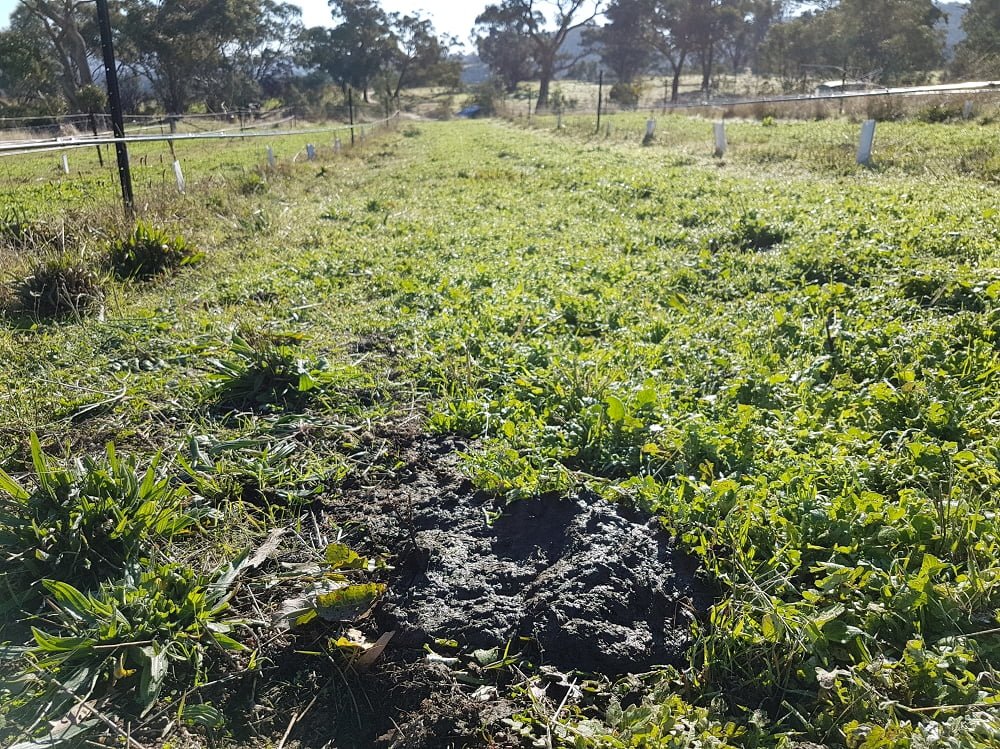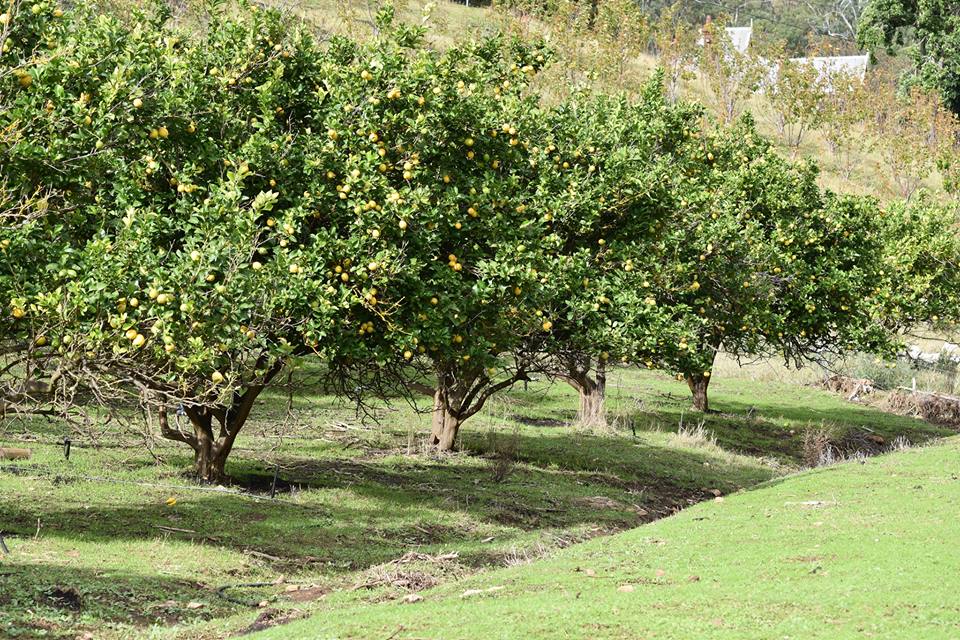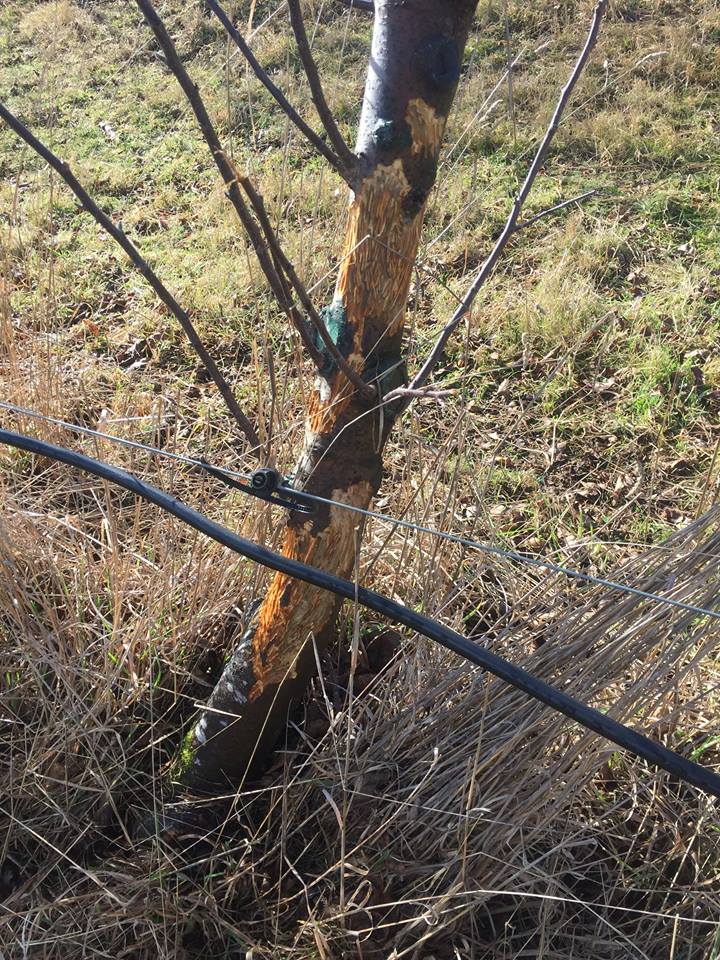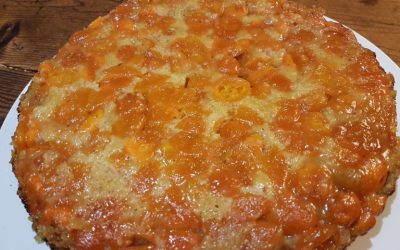Estimated reading time: 9 minutes
Do you have animals around your fruit trees? If not, would you like to?
Animals and fruit trees are a natural partnership. After all, they evolved together, so it makes sense they work well together.
Our journey with animals and fruit trees
We’d never grazed animals in the orchard before, apart from the ones we don’t want, like kangaroos, rabbits, and hares. Keeping pest animals away from your fruit trees is a vexed issue for many gardeners, particularly if you live in a regional setting.
Keeping domestic animals with fruit trees on purpose is a whole other ball game. We’d often thought of doing it—and had seen many examples of the practice in action—but had never taken the big step ourselves.
That changed when Tess Sellar joined us here at the farm and brought her lovely dairy cows.

Having cows in the orchard
Tess has been experimenting with grazing the cows in various orchards for a few years now. She works closely with the Orchard Keepers to work out a schedule.
In winter, when there are no leaves on the tree, it’s wildly successful.
The cows make good use of the feed, which saves the orchard managers from having to mow. They leave behind lots of fertiliser, and only cause minimal damage to the trees.
However, in summer when the trees have leaves, it’s a different story. It turns out that cows absolutely LOVE fruit tree leaves (as you can see in the photo at the top of this blog).
So, how do you get the benefits without getting the damage?

Learning how to mix animals with fruit trees
Fruit trees and grazing animals are a natural mix. In fact, there is a long tradition of farming them together. However, it’s a very uncommon practice in modern orchards. It’s hard to find modern orchardists with any experience of actually doing it.
We’ve been glad to be part of the ANOO network (the Australian Network of Organic Orchardists) and to learn from the experience of other small-scale organic orchardists. Then we can bring that experience to you, to try out in your backyard or small farm.
Within the ANOO network, there are growers using sheep, cows, pigs, chickens, and geese in their orchards. It’s frequently been a hot topic of conversation at the annual conference.
Sheep and fruit trees
Phil Marriot has been grazing Shropshire sheep in his organic cherry and lemon orchards. Phil finds that using the Shroppies to control the weeds under his trees brings great benefits. They:
- Keep the grass short, thereby helping to put more carbon into the soil,
- Provide free nutrition for the trees, delivered exactly where it’s needed,
- Help to control pests and diseases by cleaning up waste fruit from the ground, and
- Convert ‘waste’ organic matter (grass and fruit) into useful products like meat and wool.

Photo: Phil Marriot
While generally happy with the benefits, Phil warns of the downside. Large animals routinely eat the bottom metre or so of the foliage from both his cherry and lemon trees (as you can see in the photos above and below).
This means the fruit buds are being munched as well. Over a whole orchard, this represents a lot of prime real estate on the trees that’s wasted because it’s no longer growing any fruit.

Phil has also spent a few years building up his ‘dream team’. This is a herd of quiet, well-behaved animals that are allowed in the orchard. Naughty animals are immediately banished before they can spread their bad habits to their buddies.
In Phil’s experience, it only takes a couple of days for a new and unwelcome behaviour to spread through the whole flock.
This might include eating bark, trying to climb the trees to reach more of the foliage, or pushing through fences into areas they’re not supposed to be. Or, all three!
Sheep in a Tasmanian orchard
Matthew Tack and his wife Coreen, from Our Mates Farm in Tassie, are also big fans of using animals with fruit trees. They run Wiltshire Horn sheep under their apple trees.
They warn of the dangers of letting the animals run short on minerals. The sheep were left in an area that they thought would have been big enough to feed them for 2 weeks. Unfortunately, Matthew and Coreen returned from a trip away from the farm to find this damage (below).

Photo: Matthew Tack
According to Matthew, “It goes to show how important minerals are! These trees, fortunately, are well established and should recover. Most of this damage is from young wethers.”
Using electric fences in the orchard
Building a flock of compliant animals who behave themselves is one way to minimise damage to your trees. However, it’s quite intensive, so a more common technique is to manage the animals’ behaviour and range with electric fences.
Electric fences can be used to manage animals as diverse as sheep, cows, pigs, and chickens around your fruit trees. Of course, electric fences also have their downside. (Honestly, when is anything to do with animals ever simple?)
One of the most common complaints is the fence getting tangled in long grass and trees. This causes it to short out, which makes it ineffective. Electric fences also need to be moved regularly and require ongoing maintenance.
On a farm scale, many growers are shifting instead to permanent netting systems to divide their orchards and farms into small, manageable blocks.
However, that’s a much more capital-intensive solution. Unfortunately, that puts it out of reach for most gardeners or people with smaller lifestyle blocks.
Other ways to prevent damage to your trees include:
- Having the right number of animals. The more animals you have, the more pressure on the system, and the more likely they are to eat things you don’t want them to eat.
- Having the right mix of animals (e.g., one sheep, two ducks, and 4 chickens). This will be different for everyone and will depend on your garden, your fruit trees, and which animals you like.
- Ensuring there’s always enough feed and enough minerals available for the animals.
- Getting the timing right. As we learned with Tess’s cows in our orchard, it works better at some times of the year than others.
Choosing the right animals for your situation
Despite the drawbacks, the benefits of combining fruit trees with animals definitely outweigh the costs.
Overall, the health of any farm or garden is usually going to improve when you introduce animals to the system. As an added bonus, caring for and spending time with animals is fabulously good for your mental health.
But of course, animals take much more constant care than trees. You’ve got to pay attention to shelter, water, and protection from predators, and be always alert to their health and welfare.
If you’re interested in having animals around your fruit trees, make sure you understand the pros and cons of each animal type before you commit.
Chickens and fruit trees
For many backyard fruit growers, chickens are an easy place to start, and they are a great fit with fruit trees. They can be brilliant in helping to improve your soil.
The ideal situation is to be able to confine them around your trees for a short period, a few times a year. The best times of the year are in spring and autumn. That way, the chickens will provide the maximum benefits of cleaning up pests as they emerge from the soil in spring, and again as they are preparing to overwinter in autumn.
However, on young trees, chooks can give the tree roots a pretty hard time if you leave them in there for too long. For that reason, it’s great to have another option for where you keep them the rest of the time.
Mature trees will also benefit from not having chickens around them the entire time. The trees fare much better from having a diverse floral understorey growing under them (lots of flowers, herbs, and even vegetables). Unfortunately, they are NOT compatible with chickens!

Related Articles
To mulch or not to mulch under your fruit trees?
Mulching under fruit trees is not as good as living understory, but has its place for young trees, or for mature trees if done correctly.
Warming winter cakes with home-grown fruit
Bake delicious warming winter cakes from the fruit you’ve grown on the fruit trees in your own garden for extra satisfaction.
3 simple ways to improve your soil
Here are 3 simple ways to kickstart the health of your soil to help you grow fruit that is full of vitamins and minerals.








Thanks Katie and Hugh.
We have run sheep in the orchards over the years but always give them a mineral block for a couple of weeks leading up to them going in or they literally bolt for the bark of the trees. I like the comment about culling sheep that don’t play by the rules. Great tip.
We also ran 2 quiet old horses behind 2 high wires between the orchard rows. This worked really well, as they would reach under the fence for the grass closer to the trees, but not over the top to grab leaves. I wonder if this would work for cattle too?
I’ve pulled out the orchard plan you drew up for me a couple of years ago and implementing it (kids grown, menopause done, brain back!). Thanks so much. The orchard is looking so much better and hopefully will produce mightily this summer.
Cheers Celia
Hey Celia, thanks for the comment and great to hear from you! Thanks for the tips on the horses, that sounds like a great strategy. Glad the orchard plan is about to come into its own, good luck for this season’s harvest, hope it’s a cracker!
Hi, I ran Wiltipolls in my olive grove. Had mineral blocks and Pat Coleby’s free choice mineral supplements – but they still ended up eating the bark. In the end used electric netting fences (so ended up with long, narrow “paddocks”) which worked reasonably successfully but in the end decided that the management time wasn’t worth the output.
Would be keen to try Stroppiest – but need to find a source (probably Phil’s culls wouldn’t be ideal!)
Hi Campbell,
That’s a pity they were quite so diligent at eating bark! Phil maybe be able to help with a source for Shroppies – we could follow up with him of you like. Otherwise you could try the rare breeds society as they keep a flock book which details registered mobs.
Hope that helps.
Our wiltshires and East fresians (7 animals) got near our several fruit trees and damaged them rubbing their heads on them to scratch. Broke branches on one little tree. They knock in the pallets surrounding the trees. The chickens and geese range successfully under them but the chickens don’t eat the cherry slugs!
Hi Arianne, it’s really horses for courses – finding the right animal mix for your particular needs. Phil really stressed how important the personalities of the animals is! As soon as one shows themselves to be a trouble-maker, they’re out of the orchard!
I have read of an orchard where the bottom metre or two of fruiting trees is wrapped in chicken wire to prevent bark being eaten. seemed like a useful idea
That’s a great idea Angela, just to provide some extra security for the trees
i use kunekune pigs for last two years they are registered pigs so I know they have nothing else breed into them, they have never rooted at all they are great grazer’s I put a four foot t post in the ground on each side of each tree so when scratching they don’t actually put any pressure on the tree I have not seen any bark stripping but I do feed a mineral supplement every time I feed. My chickens also have free range of orchard for bug control. I grow legumes crimson clover, white clover, hairy vetch and winter pea as a cover in winter for nitrogen.
Wow! Sounds like a positive paradise Kelly! Thanks for sharing, and an interesting note about the mineral supplement too. Meg – GGF team.
Great article! I wish you had some info on fencing… we plan on getting cattle this spring, but we are trying to figure in the cost of fencing.
similar problem, cattle – rubbing their heads on the fruit cage mesh ( the heavy duty stuff)
and continually breaking it, only 12foot long on the side they damage so not worth buying electric fence, suggestions gratefully received as now on my 3rd panel of replacement mesh
Good day!!
I am looking at starting an intensive business, loaning weaner lambs to apple farmers for six months a year. I am hoping that I will be able to move the lambs often enough that they will not cause any damage to the trees.
I am based in the Western Cape of South Africa.
What are your thoughts?